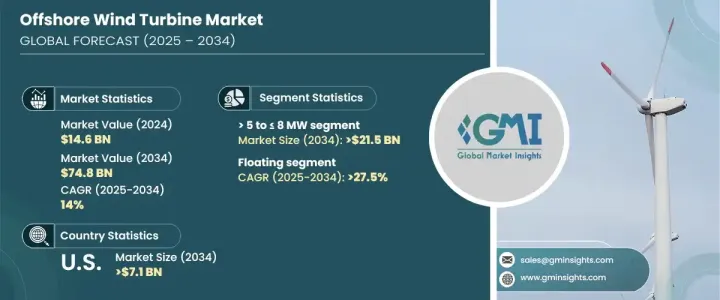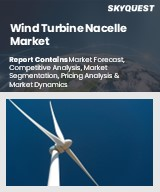
|
시장보고서
상품코드
1684850
해상 풍력 터빈 시장 기회, 성장 촉진요인, 산업 동향 분석, 예측(2025-2034년)Offshore Wind Turbine Market Opportunity, Growth Drivers, Industry Trend Analysis, and Forecast 2025 - 2034 |
||||||
세계의 해상 풍력 터빈 시장은 2024년 146억 달러에 이르렀고, 2025년부터 2034년까지 연평균 복합 성장률(CAGR) 14%를 나타낼 것으로 예측됩니다.
바람의 힘을 이용하여 발전하는 해상 풍력 터빈은 일반적으로 바다와 큰 호수와 같은 큰 수역에 설치됩니다. 이 터빈은 가혹한 해양 환경을 견딜 수 있도록 설계되었으며 수심에 따라 플로팅 플랫폼 또는 고정식 기초에 설치됩니다. 정부와 기업이 지속 가능한 에너지 솔루션을 점점 우선시하고 있으며, 재생 가능 에너지로의 전환이 진행되고 있는 것이 시장 확대의 주요 요인이 되고 있습니다.

해상 풍력에 대한 노력을 촉진하는 지원정책과 함께 깨끗한 에너지원에 대한 수요 증가와 민간 및 공적부문으로부터의 투자가 해상 풍력 기술의 채용을 가속화하고 있습니다. 에너지 가격의 변동이나 지정학적 불확실성에 의해 박차가 걸리는 에너지 다양화의 추진은 각국에 의해 신뢰성이 높고 지속 가능한 발전 옵션을 요구하도록 촉구하고 있습니다. 기술 혁신은 터빈의 효율성을 높이고 비용을 절감하며 전반적인 성능을 향상시킵니다. 또한, 그리드 통합과 에너지 저장 솔루션의 발전은 풍력에너지의 유통을 최적화하는 데 도움이 시장의 잠재력을 더욱 향상시키고 있습니다.
| 시장 규모 | |
|---|---|
| 시작 연도 | 2024년 |
| 예측 연도 | 2025-2034년 |
| 시작 금액 | 146억 달러 |
| 예측 금액 | 748억 달러 |
| CAGR | 14% |
터빈 정격의 경우 시장은 다양한 카테고리로 구분되며 터빈 정격은 2MW - 12MW입니다. 5-8MW 미만은 2034년까지 215억 달러 시장 규모에 달할 것으로 전망되고 있습니다. 이 카테고리의 터빈은 출력이 높기 때문에 비용 효율적이며 메가와트 시간당 프로젝트 비용을 줄일 수 있습니다. 이러한 터빈 수요는 우수한 효율과 낮은 평준화 에너지 비용으로 운전할 수 있는 능력에 의해 견인되고 있습니다. 그 결과, 특히 해상 풍황이 그다지 극단적이지 않은 지역에서 인기가 높아지고 있습니다. 제조업체는 이러한 터빈의 성능, 내구성 및 유연성 최적화에 계속 주력하고 있으며 시장에서 경쟁력을 높이고 있습니다.
부유식 해상 터빈 분야는 2034년까지 연평균 복합 성장률(CAGR)이 27.5%로 가장 높은 성장률이 전망되고 있습니다. 이러한 부유식 터빈은 고정저형이 실현 불가능한 심해에서의 운전이 가능하며, 미개척의 해상 풍력발전의 가능성을 풍부하게 끌어내고 있습니다. 반 다이빙, 스퍼 부이 및 텐션 레그 플랫폼을 포함한 부유 터빈 설계의 혁신은 비용 효율성과 안정성을 모두 향상시킵니다. 이러한 터빈을 더 깊은 해역에 설치할 수 있게 됨으로써, 특히 얕은 물의 자원이 한정되어 있는 지역에서는 해상 풍력 발전 프로젝트의 가능성이 확산되고 있습니다.
미국의 해상 풍력 터빈 시장도 대폭적인 성장이 예상되고 있으며, 2034년 시장 규모는 71억 달러로 예측되고 있습니다. 투자세액공제나 생산세액공제 등 정부 우대조치가 이 확대에 박차를 가하고 있습니다. 미국이 야심찬 신재생에너지 목표를 향해 노력하고 있는 가운데, 주 차원에서의 전략적 이니셔티브가 풍력발전 프로젝트를 추진하고 있습니다. 부유식 터빈 기술의 진보는 깊은 해역에서 해상 풍력 발전소로가는 길을 열고 시장 성장을 더욱 촉진하고 해상 풍력을 미국의 재생 가능 에너지의 초석으로 확고하게 만듭니다.
목차
제1장 조사 방법과 조사 범위
- 시장의 정의
- 기본 추정과 계산
- 예측 계산
- 1차 조사와 검증
- 1차 정보
- 데이터 마이닝 소스
- 시장의 정의
제2장 주요 요약
제3장 업계 인사이트
- 업계 에코시스템
- 규제 상황
- 업계에 미치는 영향요인
- 성장 촉진요인
- 업계의 잠재적 위험 및 과제
- 성장 가능성 분석
- Porter's Five Forces 분석
- PESTEL 분석
제4장 경쟁 구도
- 서론
- 전략 대시보드
- 혁신과 지속가능성의 전망
제5장 시장 규모와 예측 : 정격별(2021-2034년)
- 주요 동향
- 2 MW 이하
- 2-5MW 미만
- 5-8MW 미만
- 8-10MW 미만
- 10-12 MW
- 12 MW 이상
제6장 시장 규모와 예측 : 설치별(2021-2034년)
- 주요 동향
- 부유식
- 고정식
- 축
- HAWT
- 상풍
- 하풍
- VAWT
- HAWT
- 구성 요소
- 블레이드
- 타워
- 기타
- 축
제7장 시장 규모와 예측 : 지역별(2021-2034년)
- 주요 동향
- 북미
- 미국
- 캐나다
- 유럽
- 독일
- 스페인
- 영국
- 프랑스
- 이탈리아
- 스웨덴
- 폴란드
- 덴마크
- 포르투갈
- 네덜란드
- 아일랜드
- 벨기에
- 아시아태평양
- 중국
- 인도
- 호주
- 일본
- 한국
- 베트남
- 필리핀
- 대만
- 세계 기타 지역
제8장 기업 프로파일
- Bergey Windpower
- CSSC
- Doosan Corporation
- ENERCON
- ENESSERE
- Envision Group
- EOLINK
- General Electric
- Goldwind
- Mingyang Smart Energy Group
- NORDEX
- Orsted
- Senvion
- Siemens Gamesa Renewable Energy
- Suzlon Energy Limited
- Vattenfall
- Vestas
- WEG
The Global Offshore Wind Turbine Market reached USD 14.6 billion in 2024 and is projected to expand at a robust CAGR of 14% from 2025 to 2034. Offshore wind turbines, which harness the power of wind to generate electricity, are typically installed in large bodies of water such as oceans or large lakes. These turbines are designed to withstand the harsh marine environment and are mounted on either floating platforms or fixed foundations, depending on the water depth. The growing transition to renewable energy is a key factor driving market expansion as governments and corporations increasingly prioritize sustainable energy solutions.

Along with supportive policies promoting offshore wind initiatives, the rising demand for clean energy sources and investments from both private and public sectors are accelerating the adoption of offshore wind technologies. The drive for energy diversification, spurred by fluctuations in energy prices and geopolitical uncertainties, is pushing nations to seek more reliable and sustainable power generation options. Technological innovations are enhancing the efficiency of turbines, reducing costs, and improving overall performance. Additionally, advancements in grid integration and energy storage solutions are helping optimize the distribution of wind energy, further strengthening the market's potential.
| Market Scope | |
|---|---|
| Start Year | 2024 |
| Forecast Year | 2025-2034 |
| Start Value | $14.6 Billion |
| Forecast Value | $74.8 Billion |
| CAGR | 14% |
When it comes to the turbines' rating, the market is segmented into various categories, with turbines ranging from <= 2 MW to > 12 MW. The > 5 to <= 8 MW segment is expected to generate USD 21.5 billion by 2034. This category of turbines delivers higher power outputs, making them more cost-effective and reducing project costs per megawatt-hour. The demand for these turbines is driven by their superior efficiency and their ability to operate at a lower levelized cost of energy. As a result, they are gaining popularity, particularly in areas where offshore wind conditions are less extreme. Manufacturers are continuing to focus on optimizing the performance, durability, and flexibility of these turbines, making them more competitive in the market.
The floating offshore turbines segment is anticipated to experience the highest growth rate, with a CAGR of 27.5% by 2034. These floating turbines are capable of operating in deep waters where fixed-bottom models are not feasible, unlocking a wealth of untapped offshore wind potential. Innovations in floating turbine designs, including semi-submersible, spar buoy, and tension-leg platforms, are improving both cost efficiency and stability. The ability to deploy these turbines in deeper waters expands the range of opportunities for offshore wind projects, especially in regions with limited shallow-water resources.
The US offshore wind turbine market is also set for substantial growth, with a projected market value of USD 7.1 billion by 2034. Government incentives, including investment and production tax credits, are fueling this expansion. Strategic initiatives at the state level are pushing forward wind energy projects as the US works toward its ambitious renewable energy targets. Advances in floating turbine technology are paving the way for offshore wind farms in deeper waters, further propelling market growth and solidifying offshore wind as a cornerstone of the US renewable energy landscape.
Table of Contents
Chapter 1 Methodology & Scope
- 1.1 Market definitions
- 1.2 Base estimates & calculations
- 1.3 Forecast calculation
- 1.4 Primary research & validation
- 1.4.1 Primary sources
- 1.4.2 Data mining sources
- 1.5 Market Definitions
Chapter 2 Executive Summary
- 2.1 Industry synopsis, 2021 – 2034
Chapter 3 Industry Insights
- 3.1 Industry ecosystem
- 3.2 Regulatory landscape
- 3.3 Industry impact forces
- 3.3.1 Growth drivers
- 3.3.2 Industry pitfalls & challenges
- 3.4 Growth potential analysis
- 3.5 Porter's analysis
- 3.5.1 Bargaining power of suppliers
- 3.5.2 Bargaining power of buyers
- 3.5.3 Threat of new entrants
- 3.5.4 Threat of substitutes
- 3.6 PESTEL analysis
Chapter 4 Competitive landscape, 2024
- 4.1 Introduction
- 4.2 Strategic dashboard
- 4.3 Innovation & sustainability landscape
Chapter 5 Market Size and Forecast, By Rating, 2021 – 2034 (USD Million & MW)
- 5.1 Key trends
- 5.2 ≤ 2 MW
- 5.3 > 2 to ≤ 5 MW
- 5.4 > 5 to ≤ 8 MW
- 5.5 > 8 to ≤ 10 MW
- 5.6 > 10 to ≤ 12 MW
- 5.7 > 12 MW
Chapter 6 Market Size and Forecast, By Installation, 2021 – 2034 (USD Million & MW)
- 6.1 Key trends
- 6.1.1 Floating
- 6.1.2 Fixed
- 6.1.2.1 Axis
- 6.1.2.1.1 HAWT
- 6.1.2.1.1.1 Up-Wind
- 6.1.2.1.1.2 Down-Wind
- 6.1.2.1.2 VAWT
- 6.1.2.1.1 HAWT
- 6.1.2.2 Component
- 6.1.2.2.1 Blades
- 6.1.2.2.2 Towers
- 6.1.2.2.3 Others
- 6.1.2.1 Axis
Chapter 7 Market Size and Forecast, By Region, 2021 – 2034 (USD Million & MW)
- 7.1 Key trends
- 7.2 North America
- 7.2.1 U.S.
- 7.2.2 Canada
- 7.3 Europe
- 7.3.1 Germany
- 7.3.2 Spain
- 7.3.3 UK
- 7.3.4 France
- 7.3.5 Italy
- 7.3.6 Sweden
- 7.3.7 Poland
- 7.3.8 Denmark
- 7.3.9 Portugal
- 7.3.10 Netherlands
- 7.3.11 Ireland
- 7.3.12 Belgium
- 7.4 Asia Pacific
- 7.4.1 China
- 7.4.2 India
- 7.4.3 Australia
- 7.4.4 Japan
- 7.4.5 South Korea
- 7.4.6 Vietnam
- 7.4.7 Philippines
- 7.4.8 Taiwan
- 7.5 Rest of World
Chapter 8 Company Profiles
- 8.1 Bergey Windpower
- 8.2 CSSC
- 8.3 Doosan Corporation
- 8.4 ENERCON
- 8.5 ENESSERE
- 8.6 Envision Group
- 8.7 EOLINK
- 8.8 General Electric
- 8.9 Goldwind
- 8.10 Mingyang Smart Energy Group
- 8.11 NORDEX
- 8.12 Orsted
- 8.13 Senvion
- 8.14 Siemens Gamesa Renewable Energy
- 8.15 Suzlon Energy Limited
- 8.16 Vattenfall
- 8.17 Vestas
- 8.18 WEG


















